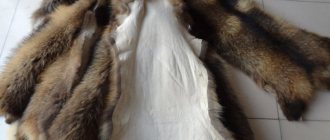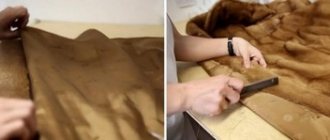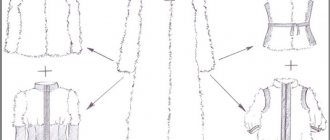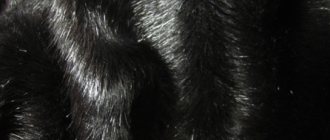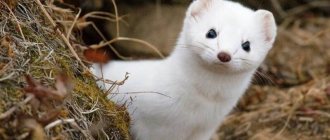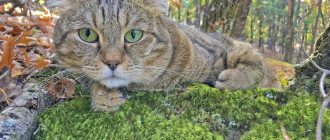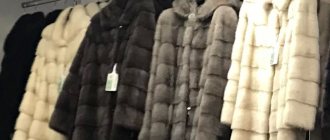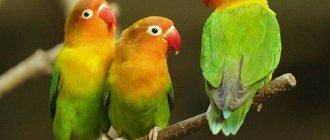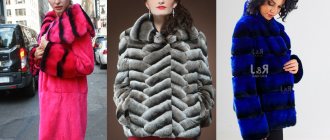Currently, chinchillas are listed in the Red Book of the International Union for Conservation of Nature and Natural Resources. Long-tailed chinchillas are farmed for their fur in many countries and are also common as pets. In 1553, the animal (apparently mixing with mountain viscachas) was mentioned in literature - in the book “Chronicle of Peru” by Pedro Cieza de Leon. The name for chinchillas was the province of Chincha (Peru). Natural habitat
The homeland of chinchillas is South America. Short-tailed chinchillas live in the Andes of southern Bolivia, northwestern Argentina and northern Chile. The long-tailed chinchilla is currently found only in a limited area of the Andes in northern Chile. Chinchillas inhabit dry rocky areas at an altitude of 400 to 5000 meters above sea level, preferring northern slopes. Rock crevices and voids under stones are used as shelters; if they are absent, the animals dig a hole. Chinchillas are perfectly adapted to life in the mountains. Chinchillas are monogamous. According to some reports, life expectancy can reach 20 years. Chinchillas lead a colonial lifestyle; They eat various herbaceous plants, mainly cereals, legumes, as well as mosses, lichens, cacti, shrubs, tree bark, and insects from animal food. Chinchillas live in colonies and are active at night. The exploitation of animals as a source of valuable fur on the European and North American markets began in the 19th century, and there is still a great demand for furs to this day. One fur coat requires about 100 skins; chinchilla products are recognized as the rarest and most expensive. In 1928, a chinchilla coat cost half a million gold marks. In 1992, a chinchilla fur coat cost $22,000. The long-tailed chinchilla is kept as a pet and bred for its fur on numerous farms. The fur of the small or long-tailed chinchilla is grayish-bluish, very soft, thick and durable. The fur of large or short-tailed chinchillas is of somewhat poorer quality. Now the rodent is protected in its original habitats in South America, but their range and numbers have been greatly reduced.
Biology
The biology of chinchillas in natural habitats has been little studied; basic data on behavior, reproduction, and physiology are obtained in artificial conditions. Most of the data relates to long-tailed chinchillas due to their mass breeding in captivity. The chinchilla's head is round in shape and its neck is short. The body length is 22 - 38 cm, the tail is 10 - 17 cm long and covered with hard guard hairs. Chinchillas are characterized by sexual dimorphism: Females are larger than males and can weigh up to 800 grams; The weight of males usually does not exceed 700 grams. Chinchillas are adapted to night life: large black eyes with vertical pupils, long (8-10 cm) whiskers, large rounded ears (5-6 cm). The chinchilla's skeleton is capable of compressing in a vertical plane, which allows animals to penetrate narrow crevices in rocks. The forelimbs are five-fingered: four grasping fingers and one little-used one are twice as long as the front five-fingered ones. The hind limbs are four-toed. Strong hind limbs are twice as long as the front ones and allow high jumps, and a highly developed cerebellum provides good coordination of movements necessary for safe movement on rocks. Chinchilla Brevicaudata is distinguished by its larger size, wide head, small bluish ears and short tail. The ears of chinchillas have special membranes, with the help of which the animals close their ears when they take sand baths; Thanks to this, sand does not get inside. Chinchillas are herbivores. Their diet is based on various herbaceous plants, mainly cereals, legumes, also seeds, mosses, lichens, shrubs, tree bark, and small insects. Chinchillas make very interesting sounds: when they don’t like something, they make a sound similar to a quack or chirp. If you make them very angry, they begin to make sounds similar to growling or blowing their nose, and sometimes click their teeth very quickly. If they get hit hard or get very scared, they can squeak very loudly. But chinchillas are not defenseless; if threatened, they can attack. They attack in a rather funny way: they stand high on their hind legs, begin to “growl”, let out a stream of urine, and then grab them with their teeth.
Where do they live?
The historical homeland of the chinchilla is South America. Colonies of animals lived almost along the entire western coast. During the period of active trapping of fur-bearing animals, hunters burned vegetation to get to their burrows and shelters. A significant decrease in the number of animals, as well as the destruction of some plant species, reduced the habitat of the genus.
Currently, chinchillas are found only in central Chile, where the Chinchilla National Reserve was created in 1983 to preserve them.
Where do chinchillas live?
The usual habitat is mountainous terrain with little vegetation. Animals make shelters for themselves between stones, in crevices, caves; if necessary, they can dig a hole or make a home in the abandoned holes of other animals.
FUR
The result of living in a cold mountain climate is thick and warm fur. Chinchillas hold the record for fur density among animals - there are more than 25,000 hairs per square centimeter of skin. Such a high density is ensured by the unusual structure of the fur: 60 - 80 very fine hairs grow from each hair follicle. Chinchillas do not have hard guard hairs; downy hairs are only 12–16 microns thick, covering hairs are 24–28 microns thick and are 4–8 mm longer than down hairs. Chinchilla fur is so dense that it cannot harbor parasites common to other fur-bearing animals. Chinchillas do not have sweat and sebaceous glands; when they get into water, their fur immediately gets wet, and the animal cannot stay on the surface. To get rid of moisture, remove lost hair and clean fur, chinchillas regularly bathe in volcanic ash and fine dust, as well as fine sand. Chinchilla belongs to the order of rodents, the chinchilla family, the genus of chinchillas, which includes 2 species - large and small chinchillas, externally differing in size. Under natural conditions, they live in the desert highlands of the Andes, in the territory of modern Chile, Peru, Bolivia and Argentina. They live in colonies, lead a twilight lifestyle, tolerate captivity well, and are very clean. Small or long-tailed chinchillas are bred on farms. Externally, the animal resembles a small rabbit. He has a stocky, well-built body, rectangular in shape, a large, beautiful head, and a short neck. The eyes are large, expressive, shiny; ears, elongated with rounded edges, slightly pubescent, widely spaced. The upper lip is slightly forked with a well-developed mustache. The hind legs are much longer than the front ones, stronger, four-toed, with calloused soles. The front paws are five-toed, with hard pads on the feet. The tail is quite long, covered with coarse hair, in healthy animals it is slightly curled upward, and when the animal moves quickly, it is extended and serves as a rudder. Adults weigh on average 500 g (maximum up to 800 g), body length 24-26 cm, tail - 14... 17 cm, ear length 5-6 cm, hind foot 6 cm. On the ventral side of the body there are 3 pairs of nipples, clearly visible in females only during lactation.
Types of chinchillas
The genus is represented by only two species.
Long-tailed
The full name of the species is the small long-tailed coastal chinchilla. Individuals have a long tail, and their ears are also slightly longer than those of short-tailed chinchillas.
It was this species that was domesticated and is used for breeding to this day. After rodent hunting was banned, long-tailed chinchillas were captured for some time to improve the genetic diversity of captive rodents.
Short-tailed
The species is also known as the royal chinchilla. A distinctive feature of individuals is a shorter tail and a large body. Representatives of the species have a hump on their nose, which allows them to breathe cold mountain air and settle at an altitude of up to 3 thousand meters above sea level.
The fur of short-tailed chinchillas is thicker and is more valuable. Until 1960, the species was considered extinct, but after that several scattered small colonies were identified, and the species was classified as endangered.
Digestive system
Chinchillas have a relatively small and narrow oral cavity, but with well-developed gums. Adult animals have 20 teeth in both jaws (upper and lower), including 4 incisors and 16 molars. The molars are set deeply in the jaw bones. The cross section of such a tooth has the shape of a square. On the grinding surface of the molars there are two transverse lamellar convexities that ensure grinding of food. The total length of these teeth is 1.2 cm. The length of the root is 0.9 cm, and the height of the crown rising above the gum is 0.3 cm. The upper and lower molars are located opposite each other, touching the entire surface. The incisors are somewhat curved. Their crowns overlap each other - the upper one on the lower one. The length of the crowns of these teeth is from 0.6 to 1.2 cm. Newborn chinchillas have 8 molars and 4 incisors. Incisors grow throughout the life of animals. The food, previously crushed by the teeth, then enters the relatively long digestive tract, which is almost 12 times longer than the chinchilla’s body. A simple single-chamber stomach is located in the left side of the abdominal cavity in the hypochondrium, has a length of 3.5 cm and a width of about 2 cm. The volume of the stomach can increase many times during the process of filling it. The small intestine is about 37 cm long. It contains the duodenum and a section of the small intestine that enters into a sac-like cecum of considerable size. Compared to the cecum of other mammals, in the chinchilla it is more adapted to digesting poor plant foods; it has numerous protuberances. The length of the cecum is on average 37.5 cm (27.8 - 42.7), width 2.4 cm (1.7 - 2.8), volume about 70 cubic cm (45-91). In the cecum, food remains for 4-5 days and undergoes further digestive processes. Basically, the breakdown of coarse fiber occurs here with the participation of numerous bacterial microflora, which, during digestion, is an additional source of protein. Absorption of water and non-protein nitrogen occurs in the large intestine. Here, too, thanks to the developed microflora, food is digested, as well as liquid is separated. The chinchilla's large intestine is very long, 2.5 times longer than the small intestine. Its internal structure ensures excellent water absorption, which is a functional adaptation of the body to the lack of water in the natural environment. The large intestine continues into the rectum, which ends at the anus. Undigested food residues, devoid of water, are removed through the anus in lumps in the form of rice grains about 0.6 cm long. The chinchilla excretes two types of feces: night and day. About 50% of the nighttime, soft feces, rich in complete microbial protein, vitamins B and K, are eaten by the chinchilla again, but it does not touch the daytime (hard) feces. The phenomenon of coprophagy (eating feces) in chinchillas is a natural and important physiological process. Night feces are similar in composition to the contents of the cecum, and, thanks to coprophagy, chinchillas “charge” the digestive tract with beneficial microflora. Thanks to coprophagy, food masses pass through the digestive tract twice and are better absorbed; the animal receives complete microbial protein and vitamins B and K, which are synthesized in the cecum.
Adult females are capable of producing 2-3 litters per year. Puberty in puppies can occur early: in females at 2-3 months, in males at 4-5 months, but generally young animals mature by 6-7 months. Females can come into heat from November to May, and its peak is in January - February. Pregnancy lasts 110..115 days. After whelping, the female can become covered again within 18 hours, that is, females combine pregnancy with lactation, some individuals are capable of this even after the second birth. But a third litter within a year is quite rare. The reproductive period lasts on average 8 years or more with a life expectancy of 15... 16 years. Reproductive ability largely depends on the conditions of detention. The female brings 1...5 cubs, most often - 2-3, but some had females who raised 5 puppies. Puppies are born covered with hair, sighted, weighing 35-65 g, and within a week they begin to eat other foods in addition to their mother's milk. Up to 8 months, the height of males and females is the same, then the latter surpass the former in terms of live weight. The chinchilla's body is covered with thick, smooth, silky fur, 2.5-3.0 cm high, with faint covering hair, forming a beautiful dark veil. The color of the hair on the back and sides of a standard chinchilla is from light gray to dark gray with a blue tint; on the abdomen it is white or bluish-white. The downy hair is slightly wavy, very thin, 12-16 microns, the coverts are twice as thick and only 4-8 mm longer than the underfur. On one square centimeter of skin surface there are more than 25 thousand hairs, significantly more than in other fur-bearing animals. The hair has a zonal color: the lower zone is dark gray, sometimes almost black or bluish, the middle zone is white, the upper zone is black, which gives the fur a beautiful play of tones on the curves of the body. The female and male do not differ in fur color. Currently, there is a wide variety of animals with different fur colors.
In nature, the long-tailed chinchilla lives in cold, dry desert conditions, where the relative humidity rarely exceeds 30%. and where there are exceptionally sharp fluctuations in air temperature. Chinchillas are very sensitive to high air humidity, especially in combination with sudden changes in temperature. On steep mountain slopes and rocky deserts, animals use natural caves and crevices as homes, where they escape the heat and cold. Hair shedding in animals of different ages does not occur simultaneously. Puppies change their hair coat 2 times until 7-9 months of age, when the formation of the hair coat ends and it matures for the first time. Adult chinchillas shed gradually throughout the year, and mass, simultaneous shedding is not observed among the entire herd. There are no seasonal differences in hair color, only hair density changes. Full maturity of the hairline in adult chinchillas occurs mainly from November to March and in some individuals lasts from several days to a month, and sometimes more.
Chinchillas are very mobile and quickly respond to external stimuli, as they have well-developed hearing and sense of smell. Chinchillas are active all year round. During the day, it is most active in the first half of the night and before dawn. The peculiarity of these rodents is that they cannot tidy their fur by combing. Therefore, to maintain their hair in a lush condition, they regularly “bathe” in dust. The chinchilla is adapted in natural conditions to feeding on dry plant food. Its main food is stems, leaves, seeds, roots and bulbs of cereals and other drought-resistant herbaceous plants, fruits, leaves and bark of evergreen shrubs, as well as cacti. All these, as well as alpine plants in general, have exceptionally high calorie content and nutritional value. Their need for water is satisfied by the moisture of the plants they eat. Chinchillas are mostly monogamous. Chinchillas mate at night. The fact of mating can be determined by indirect evidence: scraps of fur and the presence in the cell of a waxy elongated flagellum 2.5-3 cm long. With a greater degree of certainty, the fact of a female’s pregnancy can be determined by a change in her weight; the female’s gain compared to the previous weighing is 100-110 g every 15 days. Starting from the 60th day of pregnancy, the female’s nipples swell and her abdomen enlarges. Pregnant females are fed high-quality, fortified and varied food. 10 days before whelping, the nest box is filled with bedding (hay or straw) and turned over with the hole facing up so that the female does not scatter the bedding. A few days before whelping, the sand bath is removed from the cage. The male (for his safety and the female’s peace of mind) is removed from the cage or separated from the female by a partition. During the prenatal period and during childbirth, the room must be quiet; taking the female is prohibited. As birth approaches, the female moves little and does not touch the food. Most often, the female gives birth in the morning from 5 to 8 o'clock. Childbirth lasts from several minutes to several hours and occurs without outside help. During difficult births, the female is given sugar in the form of syrup 2-3 ml or sand 1.5-2 g 3-4 times a day. The cubs are born covered with down, with teeth erupted and eyes open, and on the first day they are able to move quite freely. One-day-old chinchillas are weighed and their sex is determined (in females the anal and genital openings are almost nearby, and in males they are at a much greater distance). Newborn chinchillas have a live weight of 30-70 g. Older females can give birth to more cubs than younger ones (up to 5-6 instead of 1-2). A day after giving birth, the female can be covered by the male. During the year, a female can cover herself and bring cubs 3 times, but a third covering is not advisable, since the female’s body is greatly depleted. As a rule, the female produces milk on the day of birth, but there are also delays in the appearance of milk (up to 3 days). Therefore, if the cubs are sitting hunched over, with their tail drooping, you need to examine the female. If she does not have milk, the chinchillas are placed with a dairy nurse or fed artificially: condensed milk (without sugar) diluted (1:2) in water or cow’s or goat’s milk. During the first week, the cubs are given water every 2.5-3 hours. A few days after birth, the nest box is installed with the entrance to the side so that the cubs can freely crawl out of it (for feeding). The lactation period lasts 45-60 days, at this age chinchilla chicks are approximately weaned; they can be weaned at 30 days of age, especially if the cubs are fed with boiled milk after weaning. Young animals grow quite quickly, month-old cubs are almost three times their one-day weight and weigh 114 g, at 60 days - 201 g, at 90 days - 270 g, at 120 days - 320 g, at 270-440 g and adults - 500 d. As a rule, transplanted young animals are kept in ordinary cages of several heads, females and males separately. Polygamous breeding of chinchillas is also common, when there are 2 - 4 females per male; with age, the number of females can reach up to 4 - 8.
Reproduction
Chinchillas reach sexual maturity at the age of 6-9 months, with females maturing earlier than males. Despite the fact that rodents live in colonies, mating occurs with one permanent partner.
The first rut begins in the spring. The gestation period lasts a little more than 3 months. During this time, the female noticeably gains weight, and just before giving birth, she practically stops moving. 2-3 cubs are born in one litter. The animals are born sighted, they have teeth and are covered with fur. The female feeds the babies with milk for up to two months, but already on the 2-3rd day they begin to try plant foods.
Females give birth 2-3 times a year. Re-coating by the male occurs almost immediately after birth. Despite the ability of chinchillas to produce offspring several times per season, reproduction of the species does not occur as intensively as in other rodents due to the small number of litters.
Animals reproduce well in captivity. Thanks to many years of breeding work, it was possible to obtain many varieties with different fur colors. Today on chinchilla farms you can find individuals with a standard gray color, as well as beige, silver, white, black, brown, and purple. The rarer and more difficult the color mutation to obtain, the higher the price of the chinchilla.
What to wear with a chinchilla fur coat in the 2021-2022 season
But if you become the owner of a chinchilla fur coat, the question involuntarily arises of what to wear with a chinchilla fur coat.
- First of all, it is necessary to exclude other accents, leaving this right to the fur coat.
- There is no need to add complex fur design; simple and brief additions will suffice. This model will serve as an excellent clothing option for a weekend evening or special occasions.
- No less stylish is the use of such a model with a casual ensemble, for example, with jeans and a beautiful pullover.
Coco Chanel said that truly luxurious things should be “only” for fun and always a little sloppy.
[Total: 4 Average: 2.5/5]
Interesting Facts
- Chinchillas are perhaps the only animals whose life expectancy in captivity is shorter than in their natural habitat.
- To ensure that pets are properly cared for and fed, pet owners usually try to match the animal's life stages to the human life stages. There is no single formula that will determine the age of a chinchilla by human standards. It is generally accepted that the age of 1 month in rodents corresponds to 6 months in humans, 6 months - 14-16 years, 10-12 years - 40-45 years, and 20 years - 75 years.
- The beauty of chinchilla fur prompted breeders to develop new species of other animals with similar fur. This is how the breed of chinchilla rabbits and British chinchilla cats appeared.
- Chinchillas do not shed in the usual sense of the word. A complete change of coat occurs once in young individuals; subsequently, the coat is renewed daily by the loss of some of the old hairs.
Taming and walking
Chinchillas are self-sufficient animals by nature, preferring solitude. They cannot be raised and tamed like dogs or cats, although there are exceptions. Some furry representatives show affection and happily sit in the arms of the owner.
How to tame a pet chinchilla:
- During the first days of a week of living in a new home, the rodent needs to adapt. During this period it is better to leave him alone.
- Starting from the 3rd week, you can begin taming: talk to your pet, try to open the cage and extend your hand to the chinchilla. This may interest her, she will begin to sniff the palm and quietly bite the fingers. Chinchilla bites are absolutely safe and painless.
- When the chinchilla gets used to the owner's hand, it can jump onto the palm. The owner does not need to make sudden movements and try to pull the pet out of the cage. At first, such communication procedures are enough.
- For any success in training, you can reward your chinchilla with a tasty treat.
- When the rodent gets used to the person, you can try to lure him out of the cage and put him in your arms. Prepare a treat for your furry friend in advance. Gently stroke the fur on the neck, ears and chest, encouraging the animal with kind words. Try not to stroke your chinchilla's back or sides; he won't like it.
- Communicate with the chinchilla, calling it by name, let it get used to its nickname.
- Do not pick up your chinchilla against its will. She may get scared and bite or scratch in self-defense. Another fighting technique of this rodent is shooting urine at the enemy.
If a chinchilla finds contact with its owner unpleasant, it will make a dissatisfied noise. At such moments, it is better to leave the rodent alone and postpone all attempts to tame the pet to another time. Let her calm down and get used to attention from people.
Lack of attention
Another reason for the appearance of bald patches and hair falling out in clumps is gnawing out the fur. This reason cannot be attributed to molting, since baldness is caused by mechanical damage. However, gnawing out fur is a fairly common occurrence in animals that are not given enough attention or that are kept in cramped and small cages. The emergence of a bad habit is caused by ordinary boredom.
And the fur of the animal very often looks as if tufts of wool were pulled out of the skin. It is quite easy to cope with this problem - pay more attention to your pet, move the animal into a more spacious cage, install new toys or labyrinths, or buy a pair.
